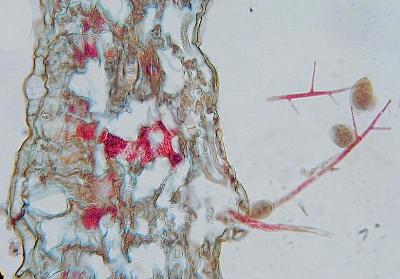
Protista- Plasmodium falciparum
Kingdom Protista consists of between and estimated 65,000 and 200,000 species. The organisms found in this Kingdom include protozoans (animal-like), algae (plant-like), and slime molds (fungus-like).
The cells of all Kingdom Protista organisms were originally formed by bacterial symbioses (symbiogenesis). It is unknown how the groups of protists are related to one another, but it is assumed they arose from certain groups of bacteria.
The organisms in this Kingdom can be unicellular, colonial, or multicellular. However, they are all eukaryotic with nuclear membranes and organelles like mitochondria and chloroplasts.
Some protists are autotrophs, such as algae, and some are heterotrophs, such as protozoa. Autotrophs manufacture their energy by photosynthesis or chemosynthesis, while the heterotrophs get their energy by consuming other organisms. All protists need some kind of a water-based environment to live in.
The organisms in Kingdom Protista don’t have any special organs to exchange gases or excrete wastes. They rely on diffusion, the passive movement of materials from an area of high concentration to an area of low concentration, to move gases and waste materials in and out of the cell. They eat by phagocytosis, which means engulfing their food in their cell membrane, and pinching off a section of membrane to form a vacuole inside the cell.
Protists do not have a very developed nervous system, but some forms have primitive mechanisms for conducting stimuli. They are aerobic and have mitochondria to conduct cellular respiration.
Most protists reproduce asexually by binary fission, but a few species are capable of sexual reproduction. Those which reproduce asexually grow by mitosis. Those which reproduce sexually, reproduce by meiosis and fertilization.
Examples of organisms in Kingdom Protista include: Plasmodium falciparum and Phytophthora infestans
Six phyla belonging to Kingdom Protista include: Ciliophora, Zoomastigina, Euglenophyta, Chlorophyta, Phaeophyta, and Rhodophyta.

Protista- Phyophthora infestans
-
Protista. (2004, November 2). Retrieved from http://biology.clc.uc.edu/courses/bio106/protista.htm
-
McNabb, C. (2002, March 27). Phase 3- kingdom protista information. Retrieved from http://pangea.tec.selu.edu/~cmcnabb/etec645/protist2.html
-
Kingdom protista. (2010). Retrieved from http://www.esu.edu/~milewski/intro_biol_two/lab_8_protista/Protista.htm
-
Major divisions of life. (1999). Retrieved from http://waynesword.palomar.edu/trmar99.htm
-
Classifications of organisms. (2006, September 8). Retrieved from http://faculty.southwest.tn.edu/rburkett/classification_of_organisms.htm